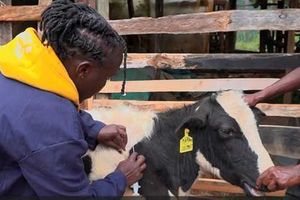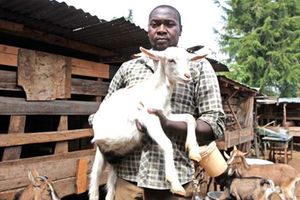
A calf waits to be fed. The risk of abortion is always there wherever there are pregnancies but most pregnancies are uneventfully carried to term.
Today, I talk about abortions in cattle; but let me first respond to two questions from farmers, emanating from two recent articles.
One farmer notified me that I had provided valuable information that triatix or amitraz does not kill fleas but I never advised on the recommended chemicals for killing fleas.
The troublesome insects are killed by products of various chemical groups. Pyrethrins are natural pyrethrum insecticides that are effective against fleas and have very low toxicity on other animals and humans. However, they are highly toxic to fish, lobsters and oysters.
I recall a client who sprayed her cat with pyrethrins next to her open fish aquarium. All the fish died from contamination with the insecticide.
Organophosphorus chemicals are effective against fleas but can also be toxic to humans and animals if improperly used. They can reach poisonous levels in the blood if ingested, inhaled or absorbed through the skin. Cats are particularly sensitive to the chemicals.
Use of the chemicals in the species is not recommended. I have treated many cats poisoned by the chemicals even in very small quantities.
Another group is pyrethroids. These are the synthetic forms of pyrethrins. They are much more potent than pyrethrins. Right mixes with water should be used to avoid poisoning the animals. Poisoning by the chemicals has no specific antidote.
Carbaryls also kill fleas and they are mainly used in powder form. They are often used to dust birds, the animals’ living environment and animals where one may not use liquid insecticides such as animals with multiple wounds.
Finally there is fipronil and closely related phenylpyrazole chemicals. These are mainly used as skin application or swallowed. Therefore, there are enough choices of the chemicals one can use to kill fleas in animals.
I have avoided to give specific commercial brands of the insecticides because I cannot list all of them and would not wish to be construed to be promoting some brands.
This is a professional and ethical requirement when discussing medical products. When one is buying an anti-flea product, they should confirm if it contains one or more of the chemicals I have mentioned.
We now return to the question of why cattle abort. I visited a farmer in Ruiru last week to flush the uterus of a repeat-breeder cow.
Once I finished, the farmer told me there was a cow which appeared to have some pink tissues protruding from the vulva but was not due to calve down.
The problem had started in the morning but there had been very little progress in discharging the pink material. According to the farmer, the animal had not strained and was eating well. It also had not been visibly sick.
On examining the cow, I found it had normal vital parameters comprising mucous membranes colour, body temperature, heartbeat, breathing rate and rumen contraction.
There were some fluid-containing membranes protruding from the vulva.I confirmed the animal was aborting. From the records and observation of the placenta buttons called cotyledons, the cow was about three months pregnant.
The cotyledons were brownish with a cooked-meat appearance and decomposing texture.
Further, the cow was not straining but the uterus kept contracting gently to evacuate the contents of the pregnancy.
From the observations, I concluded the foetus had died three to seven days earlier and was now being expelled together with the uterine fluids, placenta and its membranes.
I decided to leave the cow to complete the abortion without any interference in order to minimise the chances of injury to the uterus and infection. A major clinical policy is to not interfere with any natural process if it is progressing well on its own to avoid introducing complications.
I advised the farmer to monitor the cow and inform me if the abortion would not have been complete by the following morning. I would then return to the farm to help the cow complete the abortion.
The farmer asked me what could have caused the abortion and what causes abortions in cattle. She also wanted to know if other pregnant cows in the herd would abort.
Those were difficult questions and I had no direct and precise answer for any.
To start with, the history of the aborting cow had absolutely no information on possible causes of the abortion.
The cow had been inseminated artificially and hence infection by the semen was unlikely.
There were only two adult and docile cows in the pen with no history of fighting.
Therefore, it was unlikely the abortion was due to injury of the cow and foetus. I told the farmer it was not possible for me to tell the cause of the abortion.
As to whether other cattle could abort, it was again not possible to tell or speculate.
There was absolutely no clue what would happen with other pregnant cows.
I only consoled the farmer that most pregnancies are uneventfully carried to term.
However, if there was a specific cause of abortions on the farm, we would figure it out in due course if we established a pattern or took samples to the laboratory for analysis.
Finally, I addressed the question on why cattle abort. The risk of abortion is always there wherever there are pregnancies. There are many causes of abortions. They may be due to physical injury of the mother and foetus as occurs in falls, fights, rough vehicle rides or squeezing through hard narrow spaces.
With physical injuries, the foetus may be damaged to death or the foetal membranes may be damaged to a level that compromises blood and nutrient flow to the foetus.
In most cases, once a foetus dies, it is rejected by the body and expelled from the uterus.
Infections by disease-causing micro-organisms such as bacteria, viruses and protozoa species will cause death of the foetus and abortion. Injections of drugs like dexamethasone and PGF2 alpha also cause abortion as immature birth.
In some cases, the foetus may be incompatible with the mother and the uterus rejects it. Death of the foetus due to extreme malformation may also cause abortions. Abortion investigation is usually more successful when a number of animals in a herd are affected.






